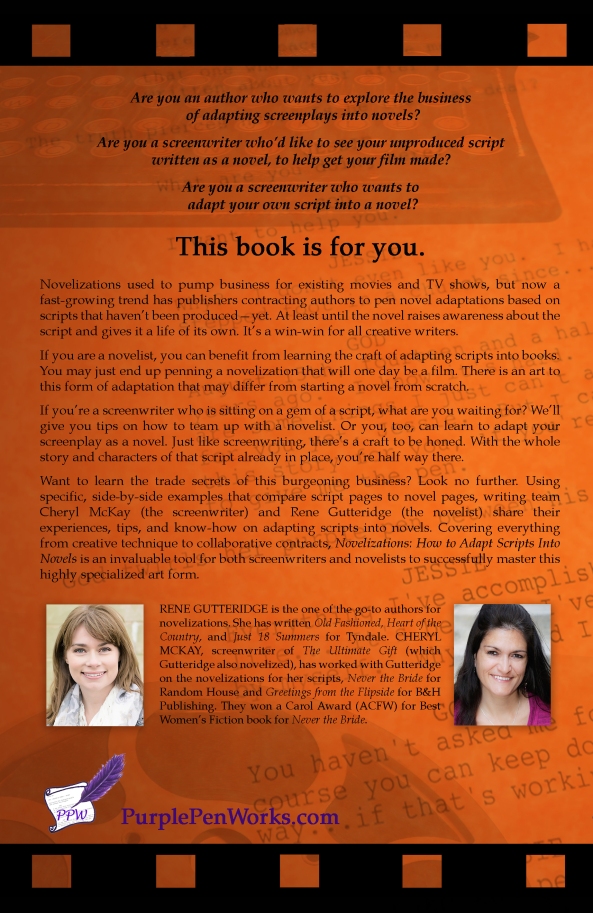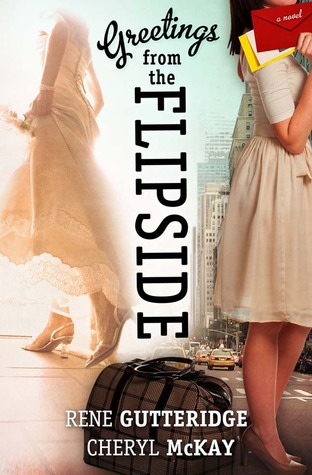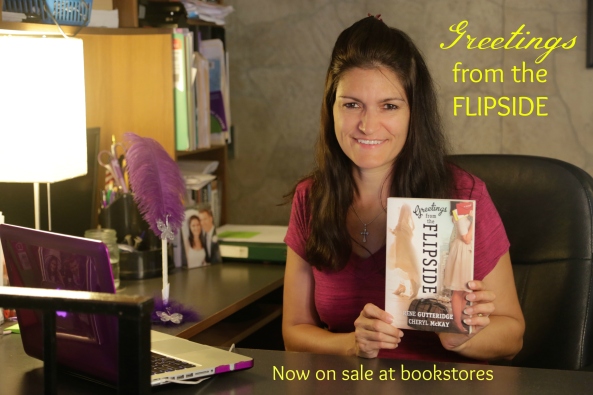* * *
Interested in learning about how to adapt a screenplay into a novel?
![Pageflex Persona [document: PRS0000035_00015]](https://cherylmckay.files.wordpress.com/2014/03/screenwritingfinal_frontcover.jpg?w=194&h=300)
Here is the first chapter of the new “How To” book by Rene Gutteridge & Cheryl McKay: Novelizations: How to Adapt Scripts Into Novels (A Writing Guide for Screenwriters and Authors)

Cheryl McKay (aka The Screenwriter)
What is a Novelization?
There is a new trend percolating in the writing industry with novelizations. I’m not talking about serials that show up on bookshelves to match every episode of your favorite TV crime drama or the book spin-offs depicting your child’s favorite TV or movie characters. Rather, there is a different trend that began in the endlessly imaginative world of Hollywood around 2008.
Most writers are familiar with the custom of taking a book and adapting it for the silver screen. That’s been around since Oliver Twist, Ben Hur, and Rip Van Winkle’s clever arrivals. But what is this reversal? Can we take screenplays—even before they are filmed—and turn them into novels? Can these novels have a life of their own, independent of a film or television release?
The novelization process, as its own piece of artistry, is a whole different form of writing; it’s literally the opposite of book-to-screen adaptations and it’s gaining popularity. This topic that—just a few years ago, you’d never heard of—is suddenly on the roster of classes at screenwriting, film, and fiction writing conferences. Rene and I have even had the chance to teach some of those.
We find this new trend exciting. Perhaps it’s because we had the privilege of getting involved on the front end of its newfound popularity before we had even heard of it.
* * *
Our Story
Our journey began in 2007. We met after Rene wrote the novelized version of my screenplay for The Ultimate Gift after it had been made into a feature film. What was unusual about that was the screenplay was already based on a book, penned by Jim Stovall. However, the producers and the publisher thought there would be value in releasing a second novel that closely matched the feature film. Rather than just rereleasing the original novel with the movie poster on the front, Thomas Nelson Publishers hired Rene to novelize my screenplay and then they published it in time for the feature film’s release.
This creative process gave us a fresh idea. What if we could get publishers to commission novels based on screenplays, even if those screenplays hadn’t yet been made into films?
If you are a screenwriter, can you imagine not having to wait for your movie to get cast, filmed, posted, and distributed to the nearest theater or Redbox to find an audience? Wouldn’t you love to start building an audience sooner?
Now you can, with what we are going to teach you through this book.
When Rene read my script Never the Bride, she knew she wanted my quirky rom-com to be the first story we worked on together. Our dream came true! In early 2008, when this new trend was barely even a concept, Random House contracted us for the novelization of Never the Bride.
Thus began the journey that has continued since that day. Collectively, we have seven of these in publication or soon-to-be released, and we plan to do more. We have learned so much about the script-to-novel writing process. We now want to share that with you. It is a different art form altogether from adapting books into scripts or writing novels from scratch.
* * *
Why Novelizations?
You may be wondering what the motive is for a screenwriter or a novelist to get involved in this process. For those writers who can do both forms of writing—why would you want to pen two projects based on the same material?
Well, it’s simple.
The film industry is risk-adverse. Check out the slate of films releasing on any given Friday. You will notice most of these projects are based on something preexisting: a novel, a nonfiction book, a comic book, a character, a true story, a historical event, a sequel, prequel or spin-off of a prior film or TV series, a remake of a prior film. (Did you know Les Miserables has been adapted into film over ten times?) Hollywood loves to know they have a built-in audience with whom to start. Otherwise, they are too afraid no one will shell out the big bucks to fill their stadium-style theater seats.
Yet screenwriters have good ideas for stories too, right? New, fresh, original. Naturally, not all screenwriters are novelists, just like most novelists wouldn’t know how to adapt their books into screenplays. (The writing rules couldn’t be more opposite!) In recent years, if executives came across a project they liked but they wanted to see if there was an audience for it, they might suggest the screenwriter get their project novelized and published first.
Besides having your story published, the benefit for the screenwriter is to be able to take meetings with studios, TV networks, and producers, and talk about how her story sold first as a novel. This gives the impression that someone else considered that story worth buying. It will give that screenwriter a leg up on other scripts in the slush pile that have no track record.
There have also been success stories in the independent publishing realm if a screenwriter released a novelization on her own and it gained a big audience. Studio executives pay attention to ebook sales, whether books are traditionally published or not, especially if there’s a large following made obvious by chatty readers in book forums. (According to an executive at a conference speaking on novelizations, it may only take the sale of 10,000 copies of an independently published novel to capture the eye of a studio.)
For novelists, this is a worthy world to dive into as well. They may find ideas they can be passionate about that will take half the work of an original novel. They have a better chance of their novelizations landing on the big screen. They have a shot at better sales if any of those novels are made into films and the novelizations rerelease with the movie posters on the front. All of this helps novelists become more visible in the film industry; it may call the attention of studios, networks, and producers to their other books. Can you say win-win?
For novelists and screenwriters, for producers and publishers, there is no downside to playing in this creative world. (So, why didn’t we think of this sooner?)
* * *
What You Will Learn in This Book
There are many questions surrounding this creative arena that we will discuss in this book. For example, how does a novelist know which stories to take on and which projects to avoid? Why is it important to not change everything the screenwriter wrote? And yet, how flexible does the screenwriter need to be when watching someone else adapt (read: change) his words?
Screenwriters, we will help you understand why the novelist will have to make some changes to your beloved, original story, its structure, its dialogue, and other areas in the translation to book form. We will also share some tips on how to make sure you are working with a team that actually wants to adapt your story.
There are patterns we have picked up on that have become helpful to recognize as we approach each novelization. Some key questions we will answer are:
• What are the challenges of novelizations?
• What makes it easier to write these books over novels written from scratch?
• What’s important to keep, to expand, or throw away from the original script’s story?
• If the screenwriter is not writing the novelization, how involved should that screenwriter be with the novelist?
• What’s the best way to form a partnership between screenwriters and novelists?
• What changes should screenwriters be flexible on and what should they fight for?
We will answer these and many other questions throughout this book.
And here’s the cool part. Since collectively, we have done this on seven projects so far, we have specific examples from our own published work, plus a few works-in-progress. You will get the chance to compare side-by-side script pages to the novelization pages that followed. We will explain our whole process: why certain parts of the novel are faithful to the script and why other parts veer off in different directions. We will show you how each writing arena follows different rules and how to use the tools unique to novelists in the novelization process.
For those screenwriters who are also aspiring novelists, there is so much you must learn to do your own adaptations. It’s like having to rewire your brain to think the exact opposite to how it functioned when you penned your screenplay. We will also give you short exercises in select chapters to put what you’re learning into practice.
We will cover such topics as setting, length, point of view, backstory, interior monologue, and the translation of dialogue, character, and structure from script-to-book.
And just a quick word about the format of this book. It’s not that we love seeing our names and titles in print. Since this book is co-written by a screenwriter and a novelist, we will label each section for you, so you know who is speaking. This way you’ll know if you are being given advice from the screenwriter’s POV or the novelist’s POV, or which one of us is doing the comparison from script to novel. Just because we don’t want to be completely annoying with agreement problems by always having to qualify a writer in the singular as a “he or she,” we will often refer to one as a “she.” We mean no disrespect to the wonderful male authors and screenwriters out there. (Rock on, Bill Myers, James Scott Bell, Tom Clancy, Nicholas Sparks!)
Are you ready to dive in with us, into this new, exciting, creative world?
* * *
(Want to know more? To get a copy of the whole book, visit the links below: )
Novelizations – How to Adapt Scripts Into Novels: A Writing Guide for Screenwriters and Authors (Paperback)


Novelizations – How to Adapt Scripts Into Novels: A Writing Guide for Screenwriters and Authors (Kindle Version)



 It’s unusual for me as a screenwriter to come across someone’s life story that I feel so compelled to chase on my own. Normally, producers find stories, option the rights, then hire to me to help draft the scripts. Two recent movies I co-wrote were Extraordinary and Indivisible both based on true stories. One comes out in Fall 2017 and the other in 2018. Even though I love coming up with original works of fiction, there’s just something about working on true stories. People relate to them because of that raw honesty that can come from people’s life experiences.
It’s unusual for me as a screenwriter to come across someone’s life story that I feel so compelled to chase on my own. Normally, producers find stories, option the rights, then hire to me to help draft the scripts. Two recent movies I co-wrote were Extraordinary and Indivisible both based on true stories. One comes out in Fall 2017 and the other in 2018. Even though I love coming up with original works of fiction, there’s just something about working on true stories. People relate to them because of that raw honesty that can come from people’s life experiences.



 Cheryl, Linda Kauffman, David A. Kauffman
Cheryl, Linda Kauffman, David A. Kauffman






![Pageflex Persona [document: PRS0000035_00015]](https://cherylmckay.files.wordpress.com/2014/03/screenwritingfinal_frontcover.jpg?w=194&h=300)








